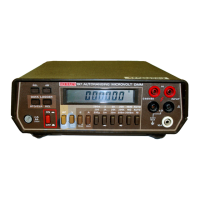CAUTION
Make a close visual inspection of the con-
nections to ensure that they are properly
connected. Otherwise, damage to the
instrument may result.
8.
Reinstall the top cover
as
explained in paragraph 5.2.
NOTE
The
IEEE
Interface options do not run off of bat-
tery power.
5.4
LINE VOLTAGE SELECTION
The Model 197 may be operated from either 105v-125V or
210v-250v, 50-60Hz. A special transformer may be installed
for 90-llOv or 195-235V operation. The instrument was ship-
ped from the factory set for an operating voltage marked on
the rear panel. To change the line voltage, proceed
as
follows:
1.
Turn off the Model 197 and disconnect
it
from line power.
2. Set the LINE VOLTAGE switch on the back of the instru-
ment to correspond to line voltage available. Example:
11OVAC is available, set the switch to 105V-125v.
CAUTION
Connect only to the line voltage selected.
Application of incorrect voltage can
damage the instrument.
IEEE
board is secured to the mother board by a support
post at the rear and connector
P1008.
To remove,
lift
the
board up until
it
disengages from the connector and sup-
port post.
1/8A, 250V, 3AG,
Slo-Blo
(Keithley Part Number FU-20)
3.
Replace the blown fuse with the following type:
CAUTl
0
N
Do
not use a fuse
with
a higher rating than
specified or instrument damage may occur.
If
the instrument persistently blows the
fuse, a problem may exist within the instru-
ment.
If
so,
the problem must be corrected
before operation may continue.
4.
If
the IEEE interface was installed, reinstall the interface as
follows:
A.
B.
C.
D.
E.
Install the rear standoffs.
Position the interface board above the rear standoffs.
WARNING
Do
not push down on
J1008.
The male con-
nector pins
will
pass through
J1008
and
may cause personal injury.
Guide the terminals of
P1008
and firmly push down on
that end
of
the board to mate the connectors.
Push down on the other side of the interface board
until
it
snaps onto the rear most standoff. Make sure
the
board is properly seated on the other two standoffs.
Reinstall the modified top cover.
5.
Reinstall the top cover
as
explained in paragraph
5.2.
5.5.2
Current Fuse Replacement
3.
Plug the power cord into a properly grounded outlet.
WARNING
Ground the instrument through a properly
grounded receptacle before operation.
Failure to ground the instrument can result
in severe injury or death
in
the event of a
short circuit or malfunction.
5.5
FUSE REPLACEMENT
5.5.1
Line Fuse Replacement
The line fuse is located internally in the Model 197. For exact
fuse location refer to Figure 5-1. To replace the fuse proceed
as follows:
1.
Remove the top cover as explained in paragraph 5.2.
2.
If
the Model 1973 or Model 1972 IEEE-488 interface is in-
stalled, it must be removed to gain access to the fuse. The
.
___
___
-
-__-~
The current fuse protects the 200pA through 2000mA ranges
from an input current greater than 2A. To replace the current
fuse, perform the following steps:
Turn off the power, disconnect the power line and remove
the test leads.
Place the end of a flat blade screwdriver into the slot of the
fuse holder on the front panel. Carfeully press in and rotate
the fuse carrier one-quarter turn counterclockwise. Release
pressure, remove the fuse and the fuse carrier from the
front panel.
Remove the defective fuse and replace
it
with the following
type:
2A, 250V, 3AG, normal blow (Keithley Part Number
FU-13) or equivalent
CAUTION
Use
only
the recommended fuse type. If a
fuse with a higher current rating is install-
ed, instrument damage may occur upon
overload.
5-2
Artisan Technology Group - Quality Instrumentation ... Guaranteed | (888) 88-SOURCE | www.artisantg.com

